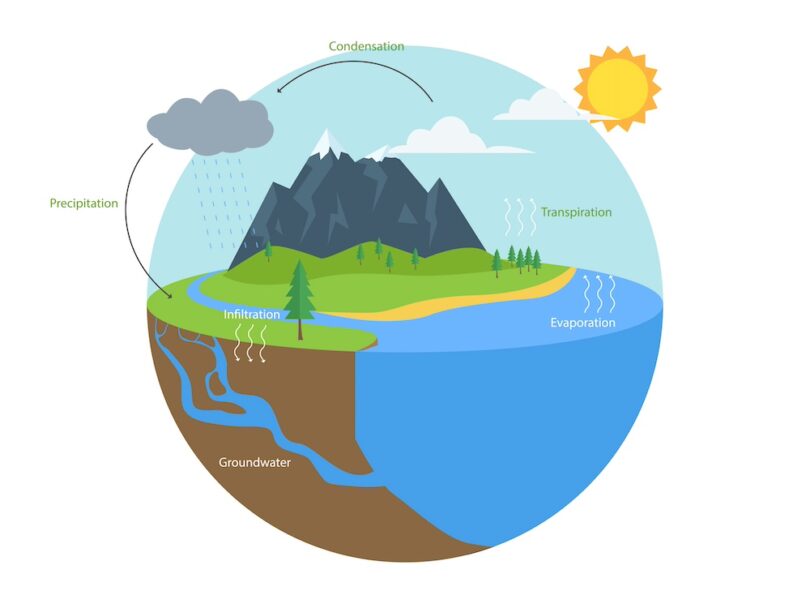Ever wondered why rain falls from the sky or how rivers flow endlessly into the sea? The answer lies in the hydrologic cycle, a fascinating natural process that has been occurring for millions of years. This blog post aims to unravel the mysteries of the hydrologic cycle, also known as the water cycle. We’ll explore its stages, significance, and how it impacts our daily lives. Whether you’re a student, an educator, or simply a curious mind, you’ll find valuable insights and practical information to deepen your understanding of this essential Earth process.
What is the Hydrologic Cycle?
The hydrologic cycle is a continuous movement of water within the Earth and atmosphere. It involves various processes such as evaporation, condensation, precipitation, and runoff. This cycle ensures that water is recycled and reused, maintaining a balance in the environment. Understanding the hydrologic cycle is crucial for grasping how water resources are managed and how weather patterns are formed.
The Role of Evaporation
Evaporation kicks off the hydrologic cycle. When the Sun heats up water bodies like oceans, rivers, and lakes, water molecules gain energy and transform into vapour. This vapour rises into the atmosphere, leaving behind salts and other impurities. Evaporation is significant because it helps regulate temperature and purify water.
The Power of Condensation
Once water vapour reaches higher altitudes, it cools down and condenses into tiny droplets, forming clouds. Condensation is an essential phase in the water cycle, as it leads to cloud formation and eventually precipitation. Clouds are visible masses of condensed water vapour that float in the atmosphere, playing a crucial role in weather patterns.
The Magic of Precipitation
Precipitation occurs when these water droplets combine to form larger drops that fall back to Earth due to gravity. This can happen in various forms, including rain, snow, sleet, or hail. Precipitation patterns vary depending on geographic location and climate, influencing everything from agriculture to river flow.
Infiltration and Groundwater
When precipitation reaches the ground, it doesn’t just run off into rivers and lakes. Some of it infiltrates the soil, replenishing groundwater reserves. Groundwater is essential for drinking water supplies and agriculture. The infiltration process also helps filter water, removing impurities and contributing to the overall quality of freshwater resources.
Surface Runoff and River Flow
Not all water that falls as precipitation infiltrates the ground. Surface runoff is the water that flows over the land, eventually making its way to rivers, lakes, and oceans. This process is crucial for maintaining river flow, which supports ecosystems and provides water for human use.
The Importance of Transpiration
Transpiration is the process by which plants absorb water through their roots and release it as vapour through their leaves. This not only helps plants stay hydrated but also contributes to the overall water cycle. Transpiration and evaporation together make up what is known as evapotranspiration, which plays a significant role in the Earth’s water balance.
The Role of Oceans
Oceans are the largest reservoirs of water on Earth, holding about 97% of the planet’s water. They play a crucial role in the hydrologic cycle by providing the bulk of the water that evaporates into the atmosphere. Ocean currents also help distribute heat around the globe, influencing climate and weather patterns.
The Impact of Human Activities
Human activities such as deforestation, urbanisation, and climate change can significantly impact the hydrologic cycle. For instance, deforestation can reduce transpiration, while urbanisation can increase surface runoff and reduce groundwater recharge. Understanding these impacts is essential for developing sustainable water management practices.
The Significance of the Hydrologic Cycle
The hydrologic cycle is vital for sustaining life on Earth. It distributes freshwater resources, regulates temperature, and supports ecosystems. Without this continuous movement of water, life as we know it would not be possible. Recognising the importance of the hydrologic cycle helps us appreciate the need for sustainable water management practices.
How Climate Change Affects the Hydrologic Cycle
Climate change is altering precipitation patterns, leading to more extreme weather events such as floods and droughts. These changes can disrupt the hydrologic cycle, making water resources less predictable and more challenging to manage. Understanding these impacts is crucial for developing strategies to mitigate and adapt to climate change.
Practical Applications of Understanding the Hydrologic Cycle
Knowledge of the hydrologic cycle has practical applications in various fields such as agriculture, urban planning, and environmental conservation. For example, understanding how water moves through the environment can help farmers optimise irrigation practices, while urban planners can design cities that better manage stormwater.
Conclusion
In summary, the hydrologic cycle is a complex but essential natural process that sustains life on Earth. From evaporation to precipitation, each stage plays a crucial role in maintaining water balance and supporting ecosystems. By understanding the hydrologic cycle, we can make more informed decisions about water management and environmental conservation. If you’re keen to learn more, consider exploring additional resources or consulting with experts in the field.
Call to Action
Ready to deepen your understanding of the hydrologic cycle? Sign up for our newsletter to receive more insightful articles and updates on environmental science. Join our community of curious minds and stay informed about the latest developments in water resource management.







